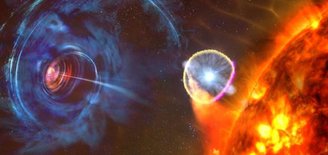Inside the Large Hadron Collider (LHC), a circular underground tunnel 27 km in circumference on the French-Swiss border, scientists are accelerating subatomic particles to speeds close to the speed of light. These collisions occur in a fraction of a second. The same conditions that existed in the Universe shortly after the Big Bang.
Amidst this sea of particles, physicists naturally look for exotic hypernuclei, as well as their antimatter counterparts, rarer, unstable, or those with unusual properties, such as antinuclei and antihypernuclei. Such research could expand our understanding of the Universe and lead to discoveries about new forces, extra dimensions or fundamental particles.
Among the numerous observations made, the international ALICE collaboration at the LHC recently announced the first evidence of anti-hyperhelium-4, which consists of two antiprotons, an antineutron and an antilambda. This is according to a (non-peer-reviewed) paper hosted on the arXiv preprint server. First observation of a heavier antimatter hypernucleus at the LHC.
We’re starting to understand hyperhelium-4
Before you realize its importance It should be emphasized that the anti-hyperhelium 4 equivalent is not ordinary matter, but an exotic baryonic particle.. It is also a form of hypernucleus composed of particles called hyperons. This means that hyperhelium-4 is not just a particle composed of protons and neutrons, but is a “modified” version of helium-4, an isotope of helium.
Helium, the lightest and second most abundant element in the universe, has a nucleus consisting of two protons and two neutrons and two electrons orbiting it. Although they are not composed of smaller particles, protons and neutrons are composed of three quarks: Protons have two up quarks and one down quark, while neutrons have one up quark and two down quarks.
But in addition to these types of quarks, there are other quarks, such as the strange quark, which, when combined with two other quarks, forms a hyperon, which is a particle similar to a neutron and proton but heavier. Although unstable, hyperons have a sufficient lifetime to combine with protons and neutrons to form hyperhelium-4, which consists of two protons, a neutron, and a lambda hyperon.
Why is antihyperhelium-4 important?

In their search for hypernuclei that contain protons and neutrons as well as hyperons, the researchers used a machine learning approach to identify signatures of hyperhydrogen-4, hyperhelium-4, and their antimatter equivalents. Signals were observed with 3.5 standard deviations; This is an indication that the evidence is solid and reliable.
Interestingly, the evidence the ALICE researchers found in the experiment was not hyperhelium-4, but its antimatter equivalent, anti-hyperhelium-4, which consists of two antiprotons, an antineutron, and an antilambda. To do this, they observed the decay products of antihelium-4, that is, the antihelium-3 nucleus, an antiproton, and a charged pion.
The importance of this discovery lies in its novelty, as so far little is known about how antimatter hypernuclei might exist or behave. Antihyperhelium-4 is the first of its kind ever observed. Because it is an extremely rare and exotic form of antimatter, studying this hypernucleus could help deepen our understanding of these oppositely charged particles.
Consequences of the discovery of the heaviest antimatter hypernucleus

In a statement, the ALICE team notes that anti-hyperhelium-4 and anti-hyperhydrogen-4 measurements are consistent with current global average values. The researchers also determined antiparticle-to-particle yield ratios and found that they were within experimental uncertainties.
Thus, they concluded that the LHC experiments carried out so far showed that antimatter and matter were produced in equal amounts. and this information informs ongoing research into the matter-antimatter imbalance in the Universe.
Stay up to date on the latest discoveries in physics at TecMundo. Until later!
Source: Tec Mundo
I’m Blaine Morgan, an experienced journalist and writer with over 8 years of experience in the tech industry. My expertise lies in writing about technology news and trends, covering everything from cutting-edge gadgets to emerging software developments. I’ve written for several leading publications including Gadget Onus where I am an author.












